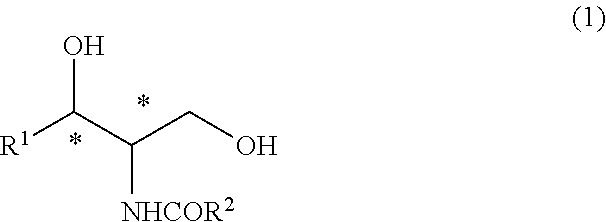Method for producing high-purity ceramide
a ceramide, high-purity technology, applied in the preparation of carboxylic acid amides, organic chemistry, carboxylic acid amide separation/purification, etc., can solve the problems of cumbersome washing procedure, poor crystal separation efficiency, and difficulty in removing butanol and/or butanol odor, etc., to achieve high purity, high yield, and high yield
- Summary
- Abstract
- Description
- Claims
- Application Information
AI Technical Summary
Benefits of technology
Problems solved by technology
Method used
Image
Examples
synthesis example 1
[0096]The asymmetric reduction of an α-amino-β-keto ester derivative was carried out according to the reaction formula to be described below.
[0097]
[0098]To a 500 ml autoclave made of hastelloy, 50 g (0.135 mol) of 2-N-acetamide-hexadecanoyl acetic acid methyl ester (hereinafter, referred to as the compound (C) in some cases), were added 370 mg (0.45 mmol) of [{RuCl((S)-(−)-SEGPHOS)}2(μ-Cl)3][Me2NH2], and 250 ml of a mixture solvent of CH2Cl2:MeOH=10:1 and the mixture was subjected to a reaction with stirring at a hydrogen pressure of 2.4 MPa and a temperature of 80° C. for 20 hours. The reaction mixture was cooled down to room temperature. The enantiomeric excess of the reaction mixture was measured using HPLC (column: CHIRALCEL OD-H, eluent: Hexane / EtOH=95 / 5 (v / v), flow rate: 0.5 ml / min, detection wavelength: UV-210 nm) and the diastereo selectivity thereof was measured using HPLC (column: Inertsil ODS-3V, eluent: methanol / water=90 / 10 (v / v), flow rate: 1.5 ml / min, column temperatur...
synthesis example 2
[0099]The asymmetric reduction was carried out according to the reaction formula to be described below in the same manner as in Synthesis Example 1.
[0100]
[0101]The yield 96.7% of (2S,3R)-2-N-acetamide-3-hydroxy octadecanoic acid methyl ester was obtained in the same manner as in Synthesis Example 1, except that [{RuCl((R)-(−)-DM-SEGPHOS)}2(μ-Cl)3][Me2NH2] was used as a catalyst in an amount of 1 / 1000 fold mol with respect to the compound (C). The enantiomeric excess was 99% e.e, and the diastereo selectivity was 95.8% d.e.
synthesis example 3
[0102]An acetyl group that is a protective group of an amino group was hydrolyzed according to the reaction formula to be described below.
[0103]
[0104]The (2R,3S)-2-N-acetamide-3-hydroxy octadecanoic acid methyl ester (47.8 g) obtained in Synthesis Example 1 was reacted with thionyl chloride such that the steric configuration of the hydroxyl group was inverted and thus was converted into a (2R,3R)-form. Thereafter, the ester moiety was reduced by sodium borohydride. Furthermore, the acetyl group was hydrolyzed to obtain (2S,3R)-2-amino octadecane-1,3-diol (40.1 g) (hereinafter, referred to as a compound (E) in some cases) (chemical purity 90%, 95% d.e.).
PUM
| Property | Measurement | Unit |
|---|---|---|
| optical purity | aaaaa | aaaaa |
| density | aaaaa | aaaaa |
| boiling point | aaaaa | aaaaa |
Abstract
Description
Claims
Application Information
 Login to View More
Login to View More - R&D
- Intellectual Property
- Life Sciences
- Materials
- Tech Scout
- Unparalleled Data Quality
- Higher Quality Content
- 60% Fewer Hallucinations
Browse by: Latest US Patents, China's latest patents, Technical Efficacy Thesaurus, Application Domain, Technology Topic, Popular Technical Reports.
© 2025 PatSnap. All rights reserved.Legal|Privacy policy|Modern Slavery Act Transparency Statement|Sitemap|About US| Contact US: help@patsnap.com



